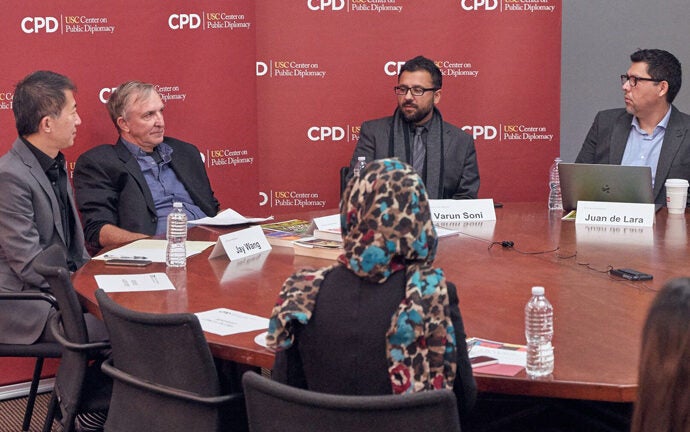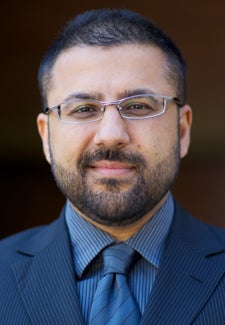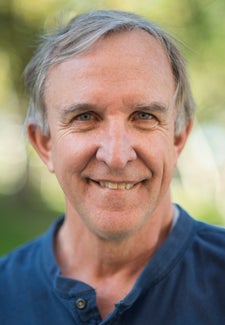
USC Dornsife scholars discuss the DNA of Los Angeles as a global city
What experiences and narratives shape Los Angeles’ global identity and why do they matter? This was the question USC Dornsife scholars Thomas Gustafson, Varun Soni and Juan de Lara addressed at “L.A. Confidential: Discovering the DNA of a Global City,” a discussion hosted by the USC Center on Public Diplomacy (CPD).
The USC Dornsife experts explored the question from a range of perspectives, including faith, race, class, architecture, literature and pop culture, as they discussed the narratives, urban landscapes and practices that make L.A. a truly global city.
With its growing profile on the world stage, they argued that it’s essential that L.A. — both its citizens and government — develop a deeper understanding of the city’s global engagement.
Incubating global trends

Varun Soni. Image courtesy of USC Media Relations.
L.A.’s diversity has a dramatic effect on religious life and community, said Soni, Dean of Religious Life. Describing L.A. as the most religiously diverse city in world history, he stressed the city’s importance as an incubator for global religion. Soni cited the key role played by L.A. in the worldwide popularization of yoga and in the growth of the global Pentecostal movement, which originated with the city’s historic Azusa Street Revival.
Soni also discussed the argument that Disney is an American religion and Disneyland a sacred space. The idea of Disney connects people across the world with meaning, purpose, significance and community with the power to transform hearts and minds in the same way as religion. “If Disneyland is indeed a religion,” he said, “then L.A. is [its] sacred center.
Soni argued that L.A’s religious diversity provides sought-after leadership in public diplomacy.
“Every few months, our office hosts delegations of foreign professionals brought to the U.S. by the State Department,” he said. “Seeing our office as a microcosm of the religious diversity of the world, they come to us to learn the ways that people of different faiths relate and cooperate on our campus and in our city. They see us as an inspiring model of how the world’s religions can co-exist and creatively engage.”
Genesis through exodus

Thomas Gustafson. Photo by Peter Zhaoyu Zhou.
Gustafson, associate professor of English and American studies and ethnicity at USC Dornsife, credited Kevin Starr, former University Professor at USC Dornsife and author of a six-book series, California and the American Dream, and alumnus, editor and author Carey McWilliams for shaping his understanding of L.A.’s DNA and its global significance.
“Starr …argues that every city has a DNA, and that L.A.’s DNA is to welcome the migrant, the eccentric, the outsider — a good gene to have if you want to evolve from a small town into a global city,” Gustafson said.
However, Gustafson argued, if one strand of L.A’s DNA is inclusion, the other is exclusion, citing the deportation of Mexicans and Mexican-Americans during the Depression, the internment of Japanese Americans during World War II and the 1943 Zoot Suit Riots.
Gustafson said McWilliams taught him that L.A.’s genesis lies in exodus. He then traced the history of migration to L.A., from the 11 multiracial families, the Pobladores, who walked from Mexico to found L.A. in 1781; to the Transcontinental railroads that linked to the city in 1881; to the depiction of the city as a land of sunshine and oranges, which brought vast migration, mainly from the Midwest; to today, where much of the city’s population identifies as multiracial.
In 1880, when USC was founded, L.A. was a town of 11,000. By 1927, it was a city of 900,000. No city is said to have grown faster in history than L.A., Gustafson noted.
“Spread between the San Gabriel mountains and the Pacific Ocean, L.A. is now the major metropolis of the American West,” he said. The early 20th century exodus of East Coast filmmakers to L.A. also made the city a storyteller to the world, he added.
A changing population
Juan de Lara. Photo by Mike Glier.
De Lara, assistant professor of American studies and ethnicity at USC Dornsife, argued that L.A. — always a global city — has been continually reshaped by boom and bust development cycles. Each development period created an image of L.A. as an idealized destination for migration. Disneyland, for example, was an idyllic anti-urban lifestyle meant to attract white suburban migrants, he argued.
Long the nation’s largest manufacturing center, L.A.’s deindustrialization coincided with a racial remapping, de Lara said, with more Latinos, Asians and Pacific Islanders arriving as whites left. Thirty-five percent of L.A. County residents are now foreign born, up from 20 percent in 1980.
What is the new economic foundation that can deliver a middle-class lifestyle and American dream for this new generation of Angelenos? de Lara asked. One solution according to policy makers has been to invest heavily in ports, logistics and distribution and in hi-tech companies.
De Lara noted that L.A. is considered the predictor for the rest of the country.
As more U.S. states and cities experience similar demographic shifts to L.A, they face the same kinds of social and political issues and social anxiety about racial change. The question, de Lara said, is how will they deal with them?
“I think the rest of the country needs to learn the lesson that we went through several years ago,” he said. “We survived. We’re thriving.”
Held on Oct. 4 on USC’s University Park campus, “L.A. Confidential: Discovering the DNA of a Global City” was moderated by Jay Wang, CPD director and associate professor of journalism at USC Annenberg School for Communication and Journalism. The discussion was part of CPD’s initiative on city diplomacy.